
The Business of Fashion
Agenda-setting intelligence, analysis and advice for the global fashion community.

Agenda-setting intelligence, analysis and advice for the global fashion community.
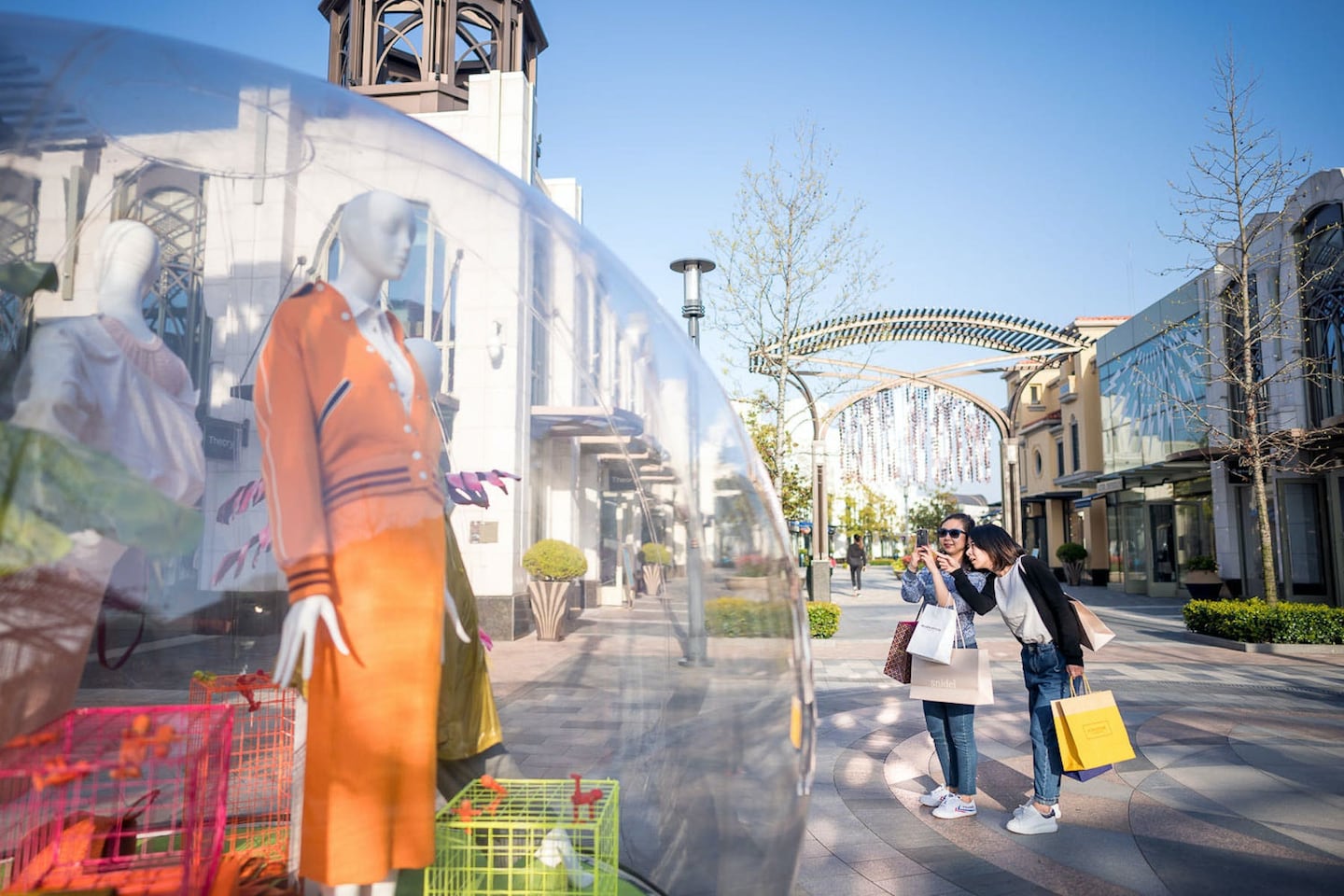
SHANGHAI, China — In early May, while the high streets of major cities in Europe and North America were emptied of customers kept home by lockdowns, one shopping mall in Shanghai had its busiest day since it opened a few years earlier — a record that was beaten the very next day, and again the next day after that.
It seems hard to believe in this age of the retail apocalypse, but during China’s nationwide May holiday period from May 1 to 5, Shanghai Village saw sales grow 63 percent compared to the same period in 2019, with customer footfall and spend per visit (SPV) metrics up across the board. But this is no ordinary shopping centre. Shanghai Village is an off-price designer outlet that sits adjacent to Shanghai Disneyland in the far reaches of suburban Pudong.
"The numbers were absolutely spectacular," said Simon Williamson, chief merchant at Value Retail China, which operates Bicester Village Shopping Collection outlets at the Art Deco-inspired Shanghai Village (a complex with almost 180 stores) and in Suzhou, which is currently undergoing an ambitious expansion that will make it the largest of the Bicester Village Shopping Collection properties around the world.
It's dangerous for brands to offer big... discounts... because that trains the consumer and they don't ever want to pay full price.
"I think there was a pent up demand [but we] also reached a new demographic as well: that traveling luxury consumer who is stuck at home, which is a big piece of our growth," he explained, adding that Value Retail's China business, even following prolonged shutdowns in the first quarter of the year, had returned to positive territory for the year-to-date by the end of May.
ADVERTISEMENT
Shoppers Return, In More Ways Than One
It seems a major repatriation in Chinese consumer spending is underway in 2020, as a significant percentage of the sales once guaranteed to outlet malls around Europe and the US from their loyal Chinese consumers are redirected to domestic retail.
It is a trend that will be welcomed by international brands desperate to make up some of the ground that is being lost elsewhere, and it is also music to the ears of China’s central government, which has been working since 2016 to repatriate at least some of the billions of dollars spent by their citizens on luxury goods overseas. Estimates vary, but it’s believed a half to two-thirds of Chinese luxury spending happens abroad.
“[For] the past five or ten years [many Chinese consumers] have done the bulk of their shopping abroad and not thought much about shopping domestically, but the market has changed significantly over [that time],” Williamson said.
In a market like China, where consumers are highly attuned to price differentials across markets and through different channels, the pumping of luxury product into outlet malls will obviously be welcomed by consumers who have been starved of overseas and travel retail options, as well as for outlets, who can improve their offering to local consumers.
For brands, however, there is a risk that short-term gain in liquidating more stock at a discount now, will come at the long-term cost to perceived brand value.
"It's dangerous for brands to offer big, broad spectrum discounts [or] price dropping on stock to move it because that trains the consumer and they don't ever want to pay full price [again]," said China Research Group Managing Director Ben Cavender.
There are other issues to consider. Although Value Retail’s China properties are currently riding a wave of repatriated spending, questions remain as to whether the change will be a permanent one. Once international travel becomes an option again, will Chinese consumers still favour their local outlets for off-price luxury?
ADVERTISEMENT
The pace of growth in the outlet space is certainly outpacing that of physical retail in China overall.
"I think that the consumer has been pleasantly surprised at what is available domestically and might think twice about whether they have to shop abroad [for off-price luxury in the future]," Williamson said, conceding that the international proportion of spend will continue to be significant but perhaps not an overwhelming proportion like it is now.
Jason Yu would be inclined to agree. According to the General Manager of Kantar Worldpanel for Greater China, even in a year that is going to be inherently challenging, there are going to be pockets of growth, including domestic spend on discounted luxury goods.
“The demand of Chinese consumers is still there; it’s just being repatriated back to China. This is something that brands and retail developers really need to be focused on this year,” he said.
Indeed, as fashion brands worldwide face a glut in inventory, many scrambled to vector more stock into China — the only major market in the world open for business for several months. According to Williamson, many of Value Retail’s international brand partners continue to look to China as a “lifeline” in 2020.
“Some brands are really pushing and pumping a lot of merchandise into this market for full-price and liquidation purposes. It means brands might come to us to do pop ups — some brands have been doing pop ups with us that have absolutely exceeded expectations — so it creates those opportunities for brands to liquidate and deal with terminal goods, but also really surprise and delight the consumers because we’re able to bring them that retail newness,” he said.
An Off-Price Culture Grows in China
However, the pandemic didn’t really cause the current rush on discount luxury shopping in China; rather, it exacerbated a trend that already existed.
Research released by real estate firm CBRE in 2019 showed that China had 110 outlet malls nationwide. Though it doesn't seem like a huge number, considering China's population and reputation as a luxury consumer powerhouse, the growth of the sector is impressive, with a building boom leading to a doubling of the country's outlet malls between 2017 and 2019.
ADVERTISEMENT
According to investment brokerage firm CGS-CIMB, sales at China's outlet malls tripled to 49.1 billion yuan ($7 billion at current exchange) between 2012 and 2016.
The pace of growth in the outlet space is certainly outpacing that of physical retail in China overall. Bailian Group, one of China’s largest retailers, reported sales at its Chinese outlet malls grew by 10.8 percent on the year in 2018, while sales at its regular shopping malls declined 1 percent over the same period.
If, as CGS-CIMB predicted in 2018, Chinese outlet malls do see annual sales grow 25 percent from 2018 to 2020, the sales growth of the sector will even have outpaced China’s spectacular growth in online sales, which swelled 24 percent in 2018 and 16.5 percent in 2019, according to National Bureau of Statistics data.
The story of China’s post-Covid consumer flocking to off-price options is echoed by other players in Shanghai, with a slightly different model to the traditional destination outlet malls.
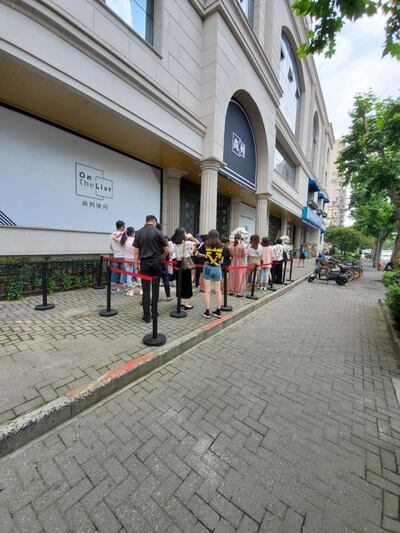
A line of shoppers outside the OnTheList showroom in Shanghai's downtown Jing'an District | Source: Courtesy
New entrant to the mainland market, OnTheList, which has operated a flash sale showroom in Hong Kong since 2016, found a willing consumer base when they finally were able to open their doors in mid-April after plans for a physical opening in Shanghai were disrupted by lockdowns.
The showroom, located in the downtown Jing'an District, walking distance from the luxury malls and multitude of office towers lining Nanjing Xi Lu, saw lines forming before 8am for its early flash sales, with hundreds of masked shoppers (largely white collar workers looking for a little retail therapy with the added buzz of bargains) popping in daily to get brands such as Sergio Rossi and Thom Browne for as much as 90 percent off.
OnTheList’s flash sale model takes terminal stock that hasn’t been sold at outlet-level discounts of 40 to 50 percent and offers itself as a “last stage” sales point for off-season inventory clearance. OnTheList Managing Director Jean Liang says its strategy, which lengthens the life-cycle of fashion products and thus contributes to lowering wastage, is popular with consumers too, with discounts starting at 70 percent. “The price point is definitely a key point impact on their purchasing behaviour. It’s a super big [point of] difference,” Liang said, adding that membership has grown to 40,000 people since the showroom opened three months ago.
"[China's coronavirus outbreak meant] we were forced to postpone the opening but, if you asked me whether this was a good time to get into the market, I would definitely say 'yes,'" said Liang, whose CV includes stints as general manager of Alexander McQueen in China and operations manager of Balmain's China business.
While some wealthy consumers continue to look for a bargain, Liang suggests that growth is now coming from middle class consumers looking to gain their first access to luxury via discounted products at many of the outlet malls that have proliferated around the country over the past decade.
“These people want to shop discounted luxury items because there is a quality guarantee at a better price,” she contended, with the coronavirus outbreak “definitely” working to accelerate the trend for discounted luxury. In addition to price sensitivity, another driver is a more uncertain economic outlook for these householders.
Though she anticipates that the cycle of luxury products from full-price, through outlet and into the flash sales pool might be accelerated for this year (not least because of the sheer amount of products that have flooded into the Chinese market), Liang cautions that this boon may only be a short-term Covid-19-induced surplus.
With factories in Italy and France shuttered for months on end this year, and many brands considering the timing and pace of new collection releases moving forward, the way luxury products move through this cycle of sales will be in flux for a while.
“Next year will be a different story,” Liang said. “But as a partner we will always do our best to help brands in the best way we can now and in the future.”
Online Options for Off-Price Are Evolving
In the early 2010’s, it was actually flash sale e-commerce sites that represented the first foray for many brands into China’s digital arena. Platforms like Mei.com and VIPshop offered thousands of discounted luxury items on their platforms at a time when the environment for e-commerce in China was all about low prices and major platforms were awash with counterfeits.
One of Alibaba’s first serious ventures into luxury fashion was its acquisition of more than 50 percent of Mei.com in 2015, at a price of $100 million. While the flash sales site became an “app-within-an-app” on the homepage of Alibaba’s Taobao and Tmall apps, the e-commerce giant worked to bring luxury brands on board to its full-price platform, Luxury Pavilion, which launched in 2017.
Over the past three years, the migration of full-price luxury online in China has been pretty much unstoppable, with even the most e-commerce-shy luxury houses – such as Chanel and Dior – acquiescing to official Luxury Pavilion stores, at least for their beauty products.
Now, Alibaba’s luxury infrastructure also boasts its own outlet offering, Luxury Soho, which launched in May and is a response to both the needs of brands to manage inventory (especially during the ongoing pandemic period), and a way to introduce these brands to a younger demographic.
"From the start, the Luxury Soho team has placed great emphasis on China’s Gen Z consumers ... it is clear that this consumer group as well as other entry-level luxury buyers have great enthusiasm for luxury brands and products. However, given their limited purchasing power in the short run, these two groups of consumers are more sensitive to prices," a Tmall Luxury spokesperson told BoF.
It is the latter driver that has analysts like Jason Yu concerned for the many brands that continue to focus on outlet mall channels in China. For Yu, to skew young in China means that a compelling online or omnichannel experience is inherently advantageous over physical outlets.
“[Young people] don’t necessarily want to drive to the outskirts of the city to visit a brick and mortar establishment. They are very happy to shop online, where they already shop for everything else.”
时尚与美容 FASHION & BEAUTY
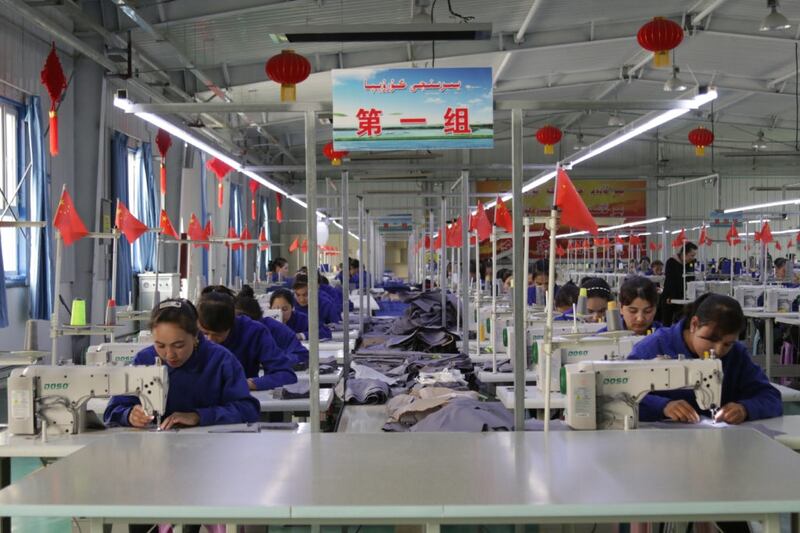
Uighur women work in a cloth factory in Hotan county, Xinjiang province, China | Source: Shutterstock
Fashion Brands Forced to Confront Uighur Labour in Supply Chains
As a growing body of research connects China's alleged forced detention of Uighurs to the supply chain of the world's largest fashion companies, a new campaign to pressure brands to end ties with factories connected to forced labour is gaining momentum. Lacoste and Adidas are among brands who have cut ties with suppliers and subcontractors implicated in forced Uighur labour. The campaign, which was started by EU Parliament member Raphaël Glucksmann, is directed at 83 companies named to be directly or indirectly benefiting from forced labour based on a March 2020 report by the Australian government-funded think tank, the Australia Strategic Policy Institute. While earlier investigations have found links to cotton sourced from Xinjiang, the ASPI report centres around the transfer of Uighur victims of mass detention from Xinjiang to factories across China that are part of the supply chain of major multinational corporations. (Glossy)
Chinese C-Beauty Unicorn Takes Step Towards IPO
The Chinese company behind the fast-growing Perfect Diary cosmetics brand has picked Goldman Sachs Group Inc. and Morgan Stanley to prepare for a potential initial public offering, according to people familiar with the matter. Guangzhou Yatsen E-Commerce Co., or Yatsen Global as it is known, aims to raise $400 million to $500 million in an offering, which could happen as soon as the end of this year, the people said. It has been considering Hong Kong among potential listing venues though no final decision has been made. (Bloomberg)
科技与创新 TECH & INNOVATION

Bilibili has built a loyal audience of young Chinese users on its unique content | Source: Bilibili.com
Bilibili Plays Matchmaker for Advertisers and Content Creators
Bilibili is a platform beloved by Chinese young people because of the richness and uniqueness of content created by its users. The introduction of a new platform, dubbed Sparkle, will open up more opportunities for these creators to tap commercial opportunities, and also make the entry into Bilibili a little more straightforward for brands looking to tap into its audience with a sense of authenticity. Based on big data from Bilibili's platform, Sparkle provides content creators with "smart" pricing recommendations, sample work showcases and access to statistics on followers and user engagement to facilitate the monetisation of high-quality content. For advertisers, Sparkle provides targeted recommendations about who to work with, data analytics, and project management tools, enhancing efficiency and giving direct access to some of China's most influential content creators. (Bilibili Press Release)
China Internet Giant Sina’s $2.7 Billion Buyout Offer
Chinese news and social media company Sina, one of the country's internet pioneers, has received a $2.7 billion management buyout offer which would spell the end of its 20-year-long Nasdaq listing. The $41-per-share offer represents a 20 percent premium to the average closing price over the last 30 days and would entail Charles Chao, Sina's chairman and chief executive, taking the company private, including its 45 percent stake in Weibo, China's version of Twitter, which is also listed on Nasdaq. The stake includes 71 percent of Weibo's voting shares and control over its board. (Financial Times)
消费与零售 CONSUMER & RETAIL
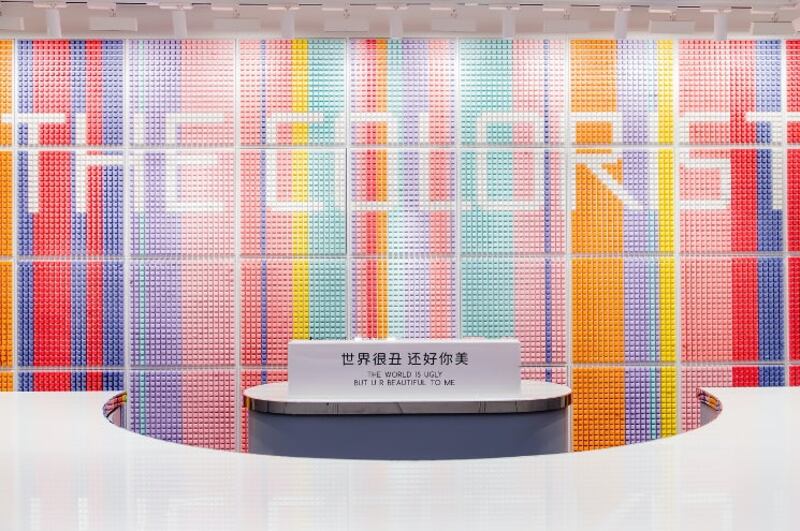
The Colorist is one of China's homegrown beauty companies finding brick and mortar to be a winning strategy | Source: Courtesy
Homegrown Beauty Retailers Boom in China
Brick and mortar beauty chains in China, such as Harmay — which started in 2010 on Taobao, but has focused on physical retail in recent year — are opening hugely popular stores in major cities like Beijing and Shanghai and attracting a crowd of young consumers on a mission of discovery. The Colorist, another home-grown player dubbed the Sephora of China, opened its first two stores simultaneously in Guangzhou and Shenzhen in October 2019, according to data from the company, these stores are consistently crowded with over 15,000 visitors per day. By April of 2020, The Colorist had expanded to over 60 stores in 20 cities nationwide. (Jing Daily)
Hainan Further Loosens Duty Free Restrictions
China's Ministry of Finance, General Administration of Customs and the State Taxation Administration announced that, as of July 1, the island of Hainan would see duty-free shopping quotas loosened from 30,000 to 100,000 yuan per year per person. Also this week, Hainan custom control released their latest regulation discouraging illegal daigou (cross-border shopping agent) behaviour. Those caught violating the regulation will forfeit their right to tax-free shopping in Hainan for three years. (China Daily)
政治,经济与社会 POLITICS, ECONOMY, SOCIETY
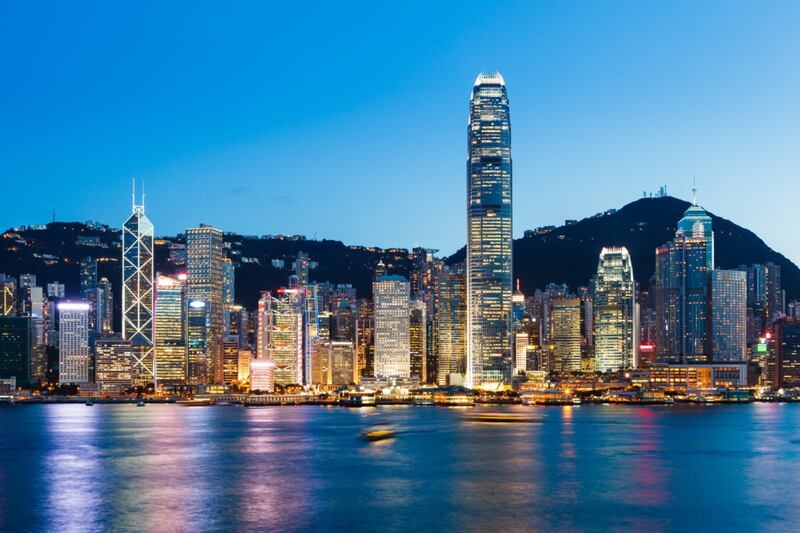
Victoria Harbour in Hong Kong | Source: Shutterstock
Hong Kong's Tourism and Retail Future Uncertain
As people turn their attention to future travel plans, Hong Kong has reason to be high on the international tourist agenda, relatively safe and with a record of keeping the Covid-19 outbreak impressively under control. The passage of a new National Security Law, however, has caused some governments, including Australian, Canada and the UK, to issue travel advisories warning their citizens that foreigners visiting Hong Kong are also subject to this new law and "may be at increased risk of arbitrary detention". This may prove a turn-off for Western tourists, but if Beijing's increased security presence works to quell street protests in Hong Kong, experts say mainland Chinese visitors are likely to return in strong numbers. (CNN Travel)
Chinese Feminism Incubates and Splinters Online
Although feminists continue to face numerous restrictions in speaking out in China, Weibo has been one of a few platforms where they've successfully grown their movement while establishing themselves as a voice to be reckoned with. But there is also a growing divide within China's online feminist circles. The two sides of the debate are the self-anointed "radical" feminists and the "academic" or "moderate" feminists. For their part, China's "academic" feminists complain the "radicals" are overly concerned with the interests of urban middle-class women. These divides tend to be exacerbated by Weibo's algorithms, which promote polarising clickbait and make it hard to bridge gaps in personal experience and ideology. (Sixth Tone)
China Decoded wants to hear from you. Send tips, suggestions, complaints and compliments to our Shanghai-based Asia Correspondent casey.hall@businessoffashion.com.
With consumers tightening their belts in China, the battle between global fast fashion brands and local high street giants has intensified.
Investors are bracing for a steep slowdown in luxury sales when luxury companies report their first quarter results, reflecting lacklustre Chinese demand.
The French beauty giant’s two latest deals are part of a wider M&A push by global players to capture a larger slice of the China market, targeting buzzy high-end brands that offer products with distinctive Chinese elements.
Post-Covid spend by US tourists in Europe has surged past 2019 levels. Chinese travellers, by contrast, have largely favoured domestic and regional destinations like Hong Kong, Singapore and Japan.